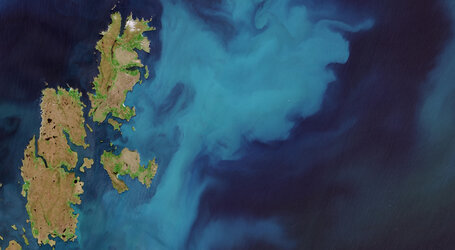Dust sparked biggest phytoplankton bloom in decades
New research reveals that dust carried by the wind from southern Africa towards Madagascar triggered the largest phytoplankton bloom in two decades – and, unusually, this occurred at a time of year when such blooms are rarely seen.
Carried by the wind, dust clouds can travel vast distances. For instance, dust from the Sahara Desert often crosses the Atlantic Ocean to the Americas. When these particles settle on land or in the ocean, they deliver essential nutrients that may boost plant growth and ocean productivity, including marine phytoplankton.
While the relationship between desertification, dust emissions, and ocean fertilisation remains poorly understood, a new paper published in PNAS Nexus marks a significant step in unravelling these connections.

The study describes how scientists working through ESA’s Living Planet Fellowships Poseidon and Pyroplankton identified a massive phytoplankton bloom off the eastern coast of southern Africa, triggered by dust wet deposition, or rain, in the nutrient-poor waters southeast of Madagascar.
The bloom, which occurred between November 2019 and January 2020, extended from southern Africa, past Madagascar, and into the open Indian Ocean, as depicted in the animation above.
John Gittings, from the University of Athens and lead author of the paper, said, “In addition to satellite data from the ESA Climate Change Initiative Ocean Colour project, we utilised information from ESA’s Climate Change Initiative Soil Moisture project and ESA’s Science for Society Biological Pump and Carbon Exchange Processes project. We also incorporated satellite data from the Copernicus Atmosphere Monitoring Service and the Copernicus Marine Service.
"Having access to such rich satellite datasets enabled us to clearly track the extent of this massive bloom and pinpoint the dust events responsible for it.
The image below shows this abnormal dust between November and December 2019.

Dr Gittings continued, "While this extensive phytoplankton bloom was highly unusual, trends in rising air temperatures, aridity, and dust emissions in southern Africa indicate that such events may become more frequent in the future.
“Alongside recent discoveries of ocean fertilisation caused by drought-induced megafires in Australia, our findings suggest a potential connection between climate change, drought, aerosols and ocean blooms.”
ESA’s Marie-Helene Rio added, “Oceans cover two-thirds of our planet and are vital to the health of our ecosystems. Understanding how climate change is altering their biological processes is not just a matter of scientific inquiry, it’s crucial for life on Earth.”















 Germany
Germany
 Austria
Austria
 Belgium
Belgium
 Denmark
Denmark
 Spain
Spain
 Estonia
Estonia
 Finland
Finland
 France
France
 Greece
Greece
 Hungary
Hungary
 Ireland
Ireland
 Italy
Italy
 Luxembourg
Luxembourg
 Norway
Norway
 The Netherlands
The Netherlands
 Poland
Poland
 Portugal
Portugal
 Czechia
Czechia
 Romania
Romania
 United Kingdom
United Kingdom
 Slovenia
Slovenia
 Sweden
Sweden
 Switzerland
Switzerland




































